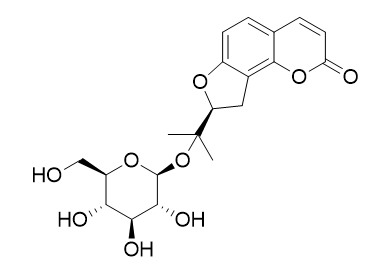Columbianetin beta-D-glucopyranoside
Columbianetin-beta-D-glucopyranoside exhibits anti-inflammatory and analgesic properties, it also shows strong inhibiting activity against platelet aggregation.
Inquire / Order:
manager@chemfaces.com
Technical Inquiries:
service@chemfaces.com
Tel:
+86-27-84237783
Fax:
+86-27-84254680
Address:
1 Building, No. 83, CheCheng Rd., Wuhan Economic and Technological Development Zone, Wuhan, Hubei 430056, PRC
Providing storage is as stated on the product vial and the vial is kept tightly sealed, the product can be stored for up to
24 months(2-8C).
Wherever possible, you should prepare and use solutions on the same day. However, if you need to make up stock solutions in advance, we recommend that you store the solution as aliquots in tightly sealed vials at -20C. Generally, these will be useable for up to two weeks. Before use, and prior to opening the vial we recommend that you allow your product to equilibrate to room temperature for at least 1 hour.
Need more advice on solubility, usage and handling? Please email to: service@chemfaces.com
The packaging of the product may have turned upside down during transportation, resulting in the natural compounds adhering to the neck or cap of the vial. take the vial out of its packaging and gently shake to let the compounds fall to the bottom of the vial. for liquid products, centrifuge at 200-500 RPM to gather the liquid at the bottom of the vial. try to avoid loss or contamination during handling.
Foods.2020, 9(10):1348.
Pharmaceuticals (Basel).2024, 17(3):352.
Sci Rep.2023, 13(1):13610.
Korean Journal of Pharmacognosy2017, 48(4):320-328
Molecules.2015, 20(10):19172-88
Front Plant Sci.2018, 9:1424
Analytical Methods2018, 10(27)
Front Immunol.2020, 11:598556.
Cancers (Basel).2023, 15(1):293.
Onco Targets Ther.2017, 10:3467-3474
Related and Featured Products
Yao Xue Xue Bao. 1989;24(7):546-51.
Studies of the active constituents of the Chinese drug [Pubmed:
2618698]
METHODS AND RESULTS:
Eight coumarins isolated from the alcohol extract of the Chinese drug "Duhuo", the root of Angelica pubescents Maxim. f. biserrata Shan et Yuan (Umbelliferae) were elucidated to be columbianetin (I), columbianetin acetate (II), columbiadin (III), osthol (IV), isoimperatorin (V), bergapten (VI), xanthotoxin (VII), and Columbianetin beta-D-glucopyranoside (VIII), by chemical and spectral analysis, compound VIII was isolated from plant for the first time.
CONCLUSIONS:
All these coumarins were tested on platelet aggregation induced by 2 microns ADP. I, II, III, IV and VIII showed strong inhibiting activity against platelet aggregation.
J Pharm Biomed Anal. 2018 May 10;153:221-231.
Simultaneous determination of columbianetin-β-d-glucopyranoside and columbianetin in a biological sample by high-performance liquid chromatography with fluorescence detection and identification of other columbianetin-β-d-glucopyranoside metabolites by u[Pubmed:
29506005]
Columbianetin beta-D-glucopyranoside (CBG) and its metabolite columbianetin (CBN) are the bioactive constituents of Angelicae pubescentis radix (APR). They exhibit the anti-platelet aggregation, anti-inflammatory and analgesic properties. The absorption, distribution, metabolism and excretion (ADME) of CBG has not been reported to date.
METHODS AND RESULTS:
Both high-performance liquid chromatography with fluorescence detection and ultra high-performance liquid chromatography coupled with quadrupole-time-of-flight mass spectrometry methods were developed and validated for the study of ADME of CBG. It was found that CBG could be catabolized into its active metabolite CBN in vivo. The absolute bioavailability of columbianetin-β-d-glucopyranoside was 5.63 ± 4.42%. The other co-existing constituents from the APR ethanol extract could enhance the absorption of CBG. CBG and CBN were rapidly and broadly distributed in the stomach, ovary, kidney, liver, spleen, lung, muscles, heart and brain. Higher levels of accumulation of CBG and CBN were detected in the ovary and kidney tissues. Eight metabolites of CBG were tentatively identified in blood, urine, bile and faeces of rats after oral administration of pure CBG. It was also found that CBG and CBN were mainly excreted through the faecal route.
CONCLUSIONS:
It can be concluded that the validated methods were successfully applied for absorption, distribution, metabolism and excretion study of CBG.



